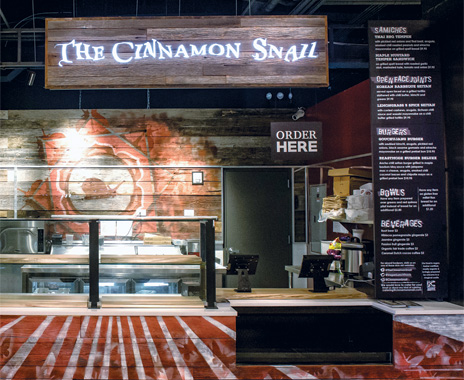Plant-based eating is gaining traction among the 98 percent of Americans who don’t identify as vegans but are attracted to the cuisine’s health and environmental benefits—not to mention its cool factor.
A 2015 survey by market analyst Mintel found that 61 percent of consumers say they enjoy menu items that heavily feature vegetables (which jumps to 75 percent among 25–34-year-olds). The use of vegetables as an ingredient also increased 5 percent between 2012 and 2015, led by kale, Brussels sprouts, and cabbage.
This increase has been helped by a slew of buzzy, veg-heavy restaurant openings that are injecting edginess and sophistication into a cuisine historically compared to rabbit food.
“A lot has to do with [plant-based cuisine] being trendy, but also with the fact that people are becoming more aware of what they’re putting in their bodies these days,” says Andie Shapira, nutritionist at Toronto-based Freshii. “People are realizing that there are negative health effects with excessive meat consumption, and more are trying to take action on health.”
She points to the success of campaigns like Meatless Mondays in rallying consumers to go meatless even once a week.
But as vegan restaurants look to reach a wider audience, they’re also battling some lingering stereotypes. When Nicole Marquis opened Philadelphia-based HipCityVeg four years ago, she was very deliberate not to use the word vegan.
“I only used plant-based to describe the food,” Marquis says. “But now that there are articles all over touting the positive health and environmental impacts of a vegan diet, I think it’s a much more familiar word and not as laden with the ethical, lifestyle issues of the past.”
Although Marquis’ own ethical views played into her decision to open a solely plant-based operation, HipCityVeg’s goal is to popularize vegan food. The quick serve–style menu includes familiar favorites like burgers and steak sandwiches made with meat substitutes like smoked tempeh and soy- and wheat gluten–derived “steak.” Marquis estimates that 70 percent of HipCityVeg customers are meat eaters.
“The most important thing for us is that we’re accessible, and everybody loves the taste of fast food,” she says, adding that she plans to open 25 restaurants in the next four to five years. “I can’t grow a business the way I’m growing it on 1 or 2 percent of the population. If I want to carry out my mission, I have to make food that’s attractive to the 98 percent who eat meat.”
Irina Kuznetsova, co-owner with her husband, Karim Raimbekov, of the newly opened Wheeling, Illinois, vegan restaurant Purple Sprout Cafe, also prefers the term plant-based, as her customers include a lot of “conventional eaters” looking to incorporate lighter, plant-based dishes into their diets.
But how does she get them in the door the first time? With desserts like raw carrot cupcakes and mint-chocolate and spinach cheesecakes. “We’ve found it’s easier to attract conventional consumers with healthy sweets, and once people try them, they’re more open to trying other things,” Kuznetsova says.
Most of the customers at New York City vegan food truck–turned fast casual The Cinnamon Snail are also meat eaters who flock to this popular spot for chef-driven sandwiches and pastries.
Owner Adam Sobel says many customers first started lining up at the truck for the 30 varieties of house-made vegan doughnuts and pastries on display. They became repeat customers on menu items like the Thai BBQ tempeh sandwich and the Gochujang Burger.
“We serve a lot of people who love the flavor of the food we make, and the fact that it’s vegan is an afterthought,” he says. “Our food is not health food, but it’s also not heavily processed.”
Sobel says the mainstream success of plant-based cuisine hinges on the availability of a range of options, with some customers seeking wholesome veggies, others looking for items like a chicken drumstick, and others responding to creative, “chefy” flavors.
Indeed, because Freshii already attracts more health-conscious customers in general, veggies are presented in more traditional forms like salads, grain bowls, and burritos. The whole menu is vegetarian or vegan with the option to add meat, though more customers are going meatless.
Serving fresh, vegetable-forward dishes at high volumes presents unique sourcing and labor challenges, however. Purple Sprout works with various suppliers to find a balance between cost and quality.
“It’s difficult to function when you’re buying produce at Whole Foods–like prices, and then factoring labor and overhead costs into your sales price on top of that,” Kuznetsova says.
Because Purple Sprout makes everything from scratch, there’s a lot of milling, soaking, sprouting, fermenting, and dehydrating before items like the Sprouted Lentil Nori Wraps are cooked and assembled.
HipCityVeg operates with higher-than-normal staff levels to accommodate seven-minute ticket times and the extra prep associated with daily vegetable deliveries. But Marquis is hopeful that by excelling at taste and convenience, HipCityVeg is primed for more lasting success as plant-based eating becomes more mainstream.
“When you see a trend like this in food, I think it speaks to a higher trend of consciousness, because what we eat has such a ripple effect,” Marquis says.






